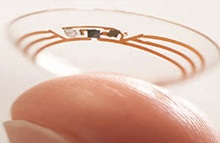- OT
- Science and vision
- Research
- Visions for the future
Visions for the future
Researcher Philip Morgan tells OT ’s Olivia Wannan of the frontiers that contact lens research teams like his are breaking through

26 April 2016
The ideas bubbling away in R&D laboratories around the world have the potential to increase the number of contact lens wearers tenfold, says University of Manchester optometry professor Philip Morgan.
WATCH THIS SPACE
Current R&D work may soon see contact lenses treat disease and save lives, for example:
1) Glucose-sensing contacts

A contact lens that actively monitors the wearer’s blood sugar could one day be a standard part of diabetic monitoring. Google is a major player in the field, patenting an externally powered glucose-sensing contact in 2014 that sends and receives a signal. A University of South Australia team, working with Contamac, is taking a different approach with a conductive but not externally powered lens. The goal is to create a lens that darkens if the glucose in the wearer’s tears indicates there is a problem in the blood glucose. Meanwhile, Google estimated in February that its lenses were “several” years from market.
2) Drug-dispensing contacts

With eye drops known for their inefficiency, researchers have spent over a decade looking at the possibility that a contact lens could dispense a medication, from a glaucoma treatment to an anti-allergy drug, over a long-term period. With medical trials – such as one delivering vitamin E to the eye for glaucoma – already putting these lenses into action, it is estimated they could be available to the public by 2020. A Massachusetts research team is also looking into a contact that can both correct vision and deliver a medication.
3) Comfort contacts

Manufacturers have long known that contact lenses become less comfortable to wear as the day progresses and that they can trigger inflammation. The development of new lens materials that avoid or address these issues are currently being sought by all major contact manufacturers, and may hit the market in the next three to five years. Researchers at Stamford have just developed a new tool that creates a replica tear film on a contact, allowing the development of contact lens that do not break this protective film.
In 20 years’ time, many patients needing visual correction will be putting a contact lens in each eye every morning, but so might people with diabetes, allergies or glaucoma, according to the Eurolens Research director.
When it comes to disease, contact lenses already play a role in diagnosis – such as 24-hour intraocular pressure monitoring contacts. Within years, contact lenses are expected to be monitoring conditions and dispensing cures as well.
Replacing the smartphone
One of Professor Morgan’s most game-changing predictions is for a smart lens – a contact lens that will display all the information a person’s smartphone does today, yet no one but the wearer will be able to see it.
The concept takes the Google Glass concept and puts it on a stand-alone contact lens, though Professor Morgan thinks the smart lens will not suffer the image problem of Google’s shelved spectacles. “People across the world would be interested in this … Potentially billions of consumers will buy this,” he said.
Professor Morgan’s best guess is that the first smart lenses will appear in 15–20 years’ time.
Before then, creating pixels on a soft, conductive and flexible surface, rather than the hard surface of an LCD screen, is one problem to be solved.
“Projecting the information so it is focused on the retina, that is going to be difficult – very, very difficult,” he emphasised.
Powering and switching the device was another challenge, he noted. But the reality might be closer than many people think – already a US company, Innovega, offers a contact lens-and-spectacles combination that projects data from a smartphone onto a wearer’s eye.
The iOptik system allows a person to see both real-world objects as well as the projected media.
A Samsung patent for a display contact lens recently made headines around the world, despite the application being filed back in September 2014.
The schematic (pictured above) filed with the application, which was registered with the Korea Intellectual Property Rights Information Service, documented a concept for a smart contact lens, rather than a prototype electronic that would be closer to market.
The concept outlined that the contact lens would give augmented reality to the wearer, and would require connection to a smartphone.
The engineers behind the Samsung patent are envisioning that a small display, a motion sensor and a microscopic camera will be able to fit into their future product.
Optometrists should keep an eye on such developments, as they may be the best placed to monitor the health of smart contact lens wearers’ eyes, he believes.
If the smart contact lens proved to be a viable alternative for the smart phone, it could increase the number of wearers tenfold, Professor Morgan estimated. “It’s very exciting for optometrists, with new areas for us to go into."
It cannot yet be known how the non-corrective contacts will be sold. However, he speculated: “As these should be considered as medical devices, optometrist oversight will be vital and they will need to be fitted and monitored appropriately.”
Crystal clear vision
Closer to reality are adjustable liquid crystal contact lenses for presbyopes – a technology Professor Morgan is more confident in predicting as he is working on bringing it to market himself.
"It's very exciting for optometrists, with new areas for us to go into"
Rather than the compromises of today’s multifocals, the liquid crystal in the contact lens will immediately switch between the needed lens powers to view close objects and distance.
CoopERVISION PARTNERSHIP
Philip Morgan recently partnered with CooperVision at a series of thought-leadership events in the UK as part of the Ready for Today initiative. The events, which took place in Bristol, Birmingham and Manchester, looked at the benefits of silicone hydrogel daily disposable contact lenses and featured a presentation by Philip Morgan entitled Stepping up to the demands of today’s contact lens wearers. Insights from research commissioned by CooperVision, investigating consumers’ current attitudes towards contact lenses and existing user behaviour, were also shared at the events and can be viewed on the CooperVision website.
With the anticipated mass manufacturing of such contact lenses, he estimated the new contacts – even down to the daily disposable – would be relatively affordable. “There’s a large market for these,” he stressed.
Professor Morgan said his team were working on the circuitry in the switch mechanism that would change the power of the contact lens. “There’s lots of difficulty in doing that.”
About five years ago, the complexity of ‘optoelectronics’ reached a point that liquid crystal contact lenses became a tangible possibility, he said. Scientific breakthroughs in the ways we can use materials, such as those for graphene, are another great help. “Graphene is conductive, flexible and transparent so it ticks all the boxes,” he highlighted.

Comments (0)
You must be logged in to join the discussion. Log in